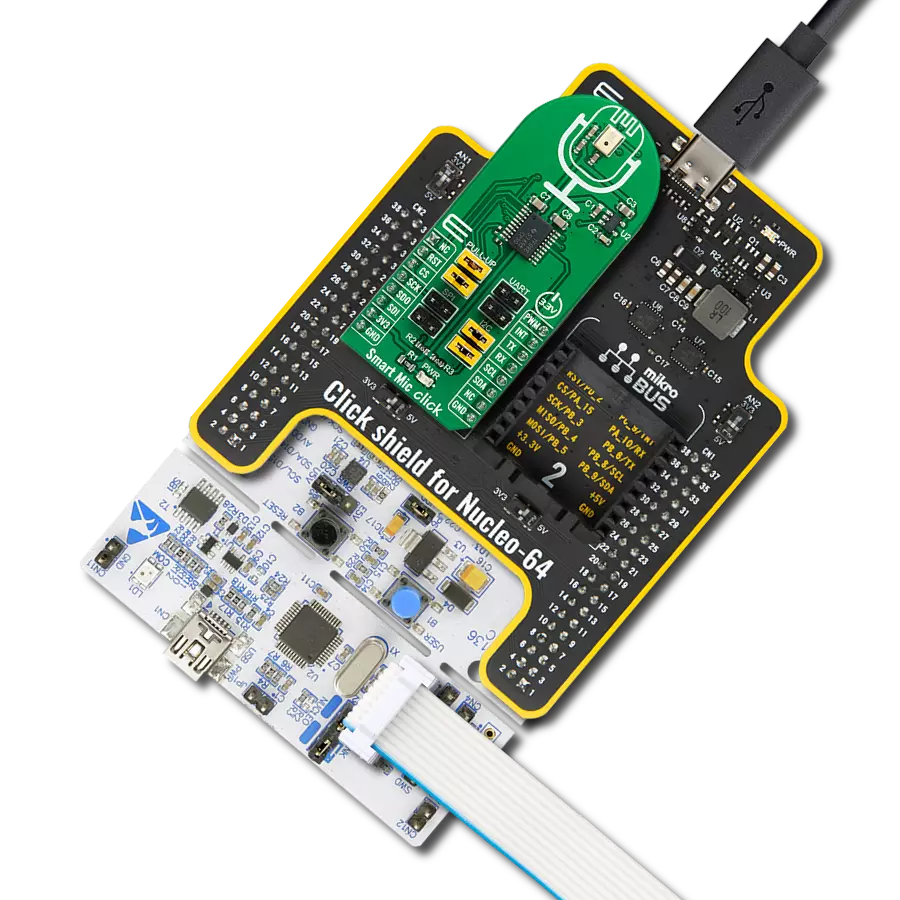Create crystal-clear audio recordings with your own custom-built microphone system
A
A
Hardware Overview
How does it work?
Mic Click is based on the SPQ0410HRSH-B, a slim ultra-mini SiSonic™ microphone specification with maximum RF protection and ultra-narrow design from Knowles. It is a MEMS microphone and consists of an acoustic sensor, a low noise input buffer, and an output amplifier. It is a very reliable microphone, resistant to mechanical shocks, vibrations, thermal shocks, low and high temperatures, ESD-HBM, and more. It is not resistant to high pressure and vacuum. The
microphone is top-port oriented and has a typical sensitivity of -42dB at 94dB SPL, with a 59dB signal-to-noise ratio. Mic Click uses an analog OUT pin of the mikroBUS™ socket to communicate with the host MCU. The analog output from the microphone to the OUT pin goes through the MCP6022, a rail-to-rail input/output 10MHz Op Amp from Microchip. This operational amplifier has a wide bandwidth, low noise, low input offset voltage, and low distortion and amplifies the
microphone's output with high performance. This Click board™ can be operated only with a 3.3V logic voltage level. The board must perform appropriate logic voltage level conversion before using MCUs with different logic levels. Also, it comes equipped with a library containing functions and an example code that can be used as a reference for further development.
Features overview
Development board
Nucleo 32 with STM32F031K6 MCU board provides an affordable and flexible platform for experimenting with STM32 microcontrollers in 32-pin packages. Featuring Arduino™ Nano connectivity, it allows easy expansion with specialized shields, while being mbed-enabled for seamless integration with online resources. The
board includes an on-board ST-LINK/V2-1 debugger/programmer, supporting USB reenumeration with three interfaces: Virtual Com port, mass storage, and debug port. It offers a flexible power supply through either USB VBUS or an external source. Additionally, it includes three LEDs (LD1 for USB communication, LD2 for power,
and LD3 as a user LED) and a reset push button. The STM32 Nucleo-32 board is supported by various Integrated Development Environments (IDEs) such as IAR™, Keil®, and GCC-based IDEs like AC6 SW4STM32, making it a versatile tool for developers.
Microcontroller Overview
MCU Card / MCU

Architecture
ARM Cortex-M0
MCU Memory (KB)
32
Silicon Vendor
STMicroelectronics
Pin count
32
RAM (Bytes)
4096
You complete me!
Accessories
Click Shield for Nucleo-32 is the perfect way to expand your development board's functionalities with STM32 Nucleo-32 pinout. The Click Shield for Nucleo-32 provides two mikroBUS™ sockets to add any functionality from our ever-growing range of Click boards™. We are fully stocked with everything, from sensors and WiFi transceivers to motor control and audio amplifiers. The Click Shield for Nucleo-32 is compatible with the STM32 Nucleo-32 board, providing an affordable and flexible way for users to try out new ideas and quickly create prototypes with any STM32 microcontrollers, choosing from the various combinations of performance, power consumption, and features. The STM32 Nucleo-32 boards do not require any separate probe as they integrate the ST-LINK/V2-1 debugger/programmer and come with the STM32 comprehensive software HAL library and various packaged software examples. This development platform provides users with an effortless and common way to combine the STM32 Nucleo-32 footprint compatible board with their favorite Click boards™ in their upcoming projects.
Used MCU Pins
mikroBUS™ mapper
Take a closer look
Click board™ Schematic

Step by step
Project assembly
Software Support
Library Description
This library contains API for MIC Click driver.
Key functions:
mic_generic_read- This function read ADC data
Open Source
Code example
The complete application code and a ready-to-use project are available through the NECTO Studio Package Manager for direct installation in the NECTO Studio. The application code can also be found on the MIKROE GitHub account.
/*!
* \file
* \brief Mic Click example
*
* # Description
* This example showcases the initialization and configuration of the Click and logger
* modules and later on reads and displays data recorded by the mic.
*
* The demo application is composed of two sections :
*
* ## Application Init
* Initializes LOG communication, ADC and configures AN pin as input on MIKROBUS1.
*
* ## Application Task
* Reads 12 bit ADC data from AN pin and displays it using the logger module.
*
* \author MikroE Team
*
*/
// ------------------------------------------------------------------- INCLUDES
#include "board.h"
#include "log.h"
#include "mic.h"
// ------------------------------------------------------------------ VARIABLES
static mic_t mic;
static log_t logger;
// ------------------------------------------------------ APPLICATION FUNCTIONS
void application_init ( void )
{
log_cfg_t log_cfg;
mic_cfg_t cfg;
/**
* Logger initialization.
* Default baud rate: 115200
* Default log level: LOG_LEVEL_DEBUG
* @note If USB_UART_RX and USB_UART_TX
* are defined as HAL_PIN_NC, you will
* need to define them manually for log to work.
* See @b LOG_MAP_USB_UART macro definition for detailed explanation.
*/
LOG_MAP_USB_UART( log_cfg );
log_init( &logger, &log_cfg );
log_info( &logger, "---- Application Init ----" );
// Click initialization.
mic_cfg_setup( &cfg );
MIC_MAP_MIKROBUS( cfg, MIKROBUS_1 );
mic_init( &mic, &cfg );
}
void application_task ( void )
{
mic_data_t tmp;
// Task implementation.
tmp = mic_generic_read ( &mic );
log_printf( &logger, "** ADC value : [DEC]- %d, [HEX]- 0x%x \r\n", tmp, tmp );
Delay_ms ( 1000 );
}
int main ( void )
{
/* Do not remove this line or clock might not be set correctly. */
#ifdef PREINIT_SUPPORTED
preinit();
#endif
application_init( );
for ( ; ; )
{
application_task( );
}
return 0;
}
// ------------------------------------------------------------------------ END
Additional Support
Resources
Category:Microphone



































